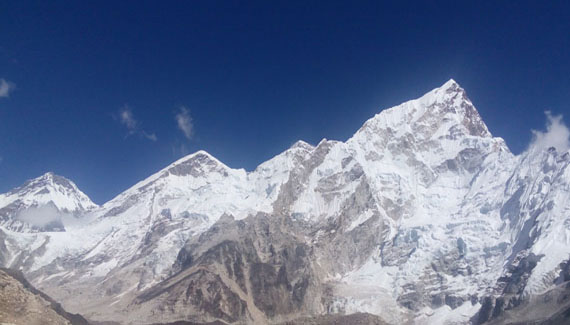Mount Everest
The name of widely recognized Mount Everest is as interesting as the mountain itself. The survey of India first ever named the peak as ‘Peak XV’ but later same was renamed as Everest after the than General of east India company, Sir George Everest. It was later after many years perceived that the peak had already had a name – the local inhabitant famous as Sherpa’s called it Chomolongma, after a female guardian deity who is believed to be one of the 5 sisters of long life and who rode a red tiger. It was in 1956 when one of the Historians in Nepal named it Sagarmatha, meaning ‘head of the sky’, which has been the name of the mountain since than for the entire nation.
The height of the peak was equally debated as the name and in early days the summit was said to be 8838 meters, very soon in 1954 it was revised to 8848m, in 1999 the team from National Geography claimed the zenith of Everest as 8850m, and further in 2002 a Chinese team claimed its height as 8844 meters but nevertheless Nepalese and Chinese government again started the survey in 2019 and finished the survey in May 2020. The revised height of the world’s highest peak revealed is 8848.86 meters. Now the world proudly introduces Everest’s new height as 8848.86 meters.
After 1976 Mt. Everest homes in the most famous reserve of ‘Sagarmatha National Park’, which spreads out to 1148 sq. Km. The national park in 1979 had been announced as UNESCO world heritage site in order to preserve the natural ambiance of the mountains, its flora and its fauna.
Include all mountains in the Everest region
There are around 6000 mountains in the Everest region of Nepal, ranging from the 5000m all the way to 8000 meters. Mount Everest, it is impossible for the surveyors to name the peaks, which is why till the day most of them are unnamed and it is as well impossible for us to name the entire peaks present in the region. Some of the prominent peaks are Everest, Lhotse, Cho Oyu, Gyachung Kang, Nuptse, Nangpai Gosum, Pumori, Khumbutse, Taboche, Cholatse, Kala patthar, Gokyo Ri, Ama Dablam, Thamserku, Lhotse, Katenga and many others.
The Sherpa of Everest Region
The lower region of Solukhumbu is inhabited by communities of different cast and religion, but as we ascend from Sete, we see the trail encompasses through the Sherpa land. Although majority of the world know potters as Sherpa or any Tibeto-Burman community with similar facial resemblance, living in the high altitude as Sherpas but the only community from the Khumbu region and Helambu region are considered as true Sherpa.
Sherpas are the Buddhist tribes who migrated to the Everest region and Himalayas of Nepal, from Tibetan plateau, in the 15th century. Known to the world as Sherpa is in fact Ser-wa, which means people from the east, they speak language which has been derived from Tibet and has no written dialect and follow the customs of Tibet as well.
Ever since the first expedition in 1950’s, the Sherpas are recognized as the super humans of thin air for their skills as mountaineers and high – altitude porters.
Include flora and fauna in the Everest region
There is very less in terms of vegetation that can be found on the higher altitudes of the Everest region and moss is the only the thing found in the higher altitude of the region. Birds in the region have been very remarkable and some of the species seen are bar headed goose, chough and yellow billed Geese are seen as high as 7,500m from the sea level. Red panda, snow leopard, Himalayan Thar are very rare species which is seen on a very lucky day, whereas Yaks are prominent animals of the Everest.





